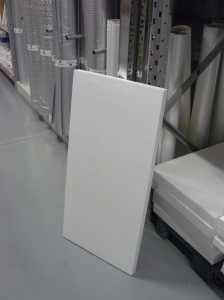 Styropor (Styrofoam) was invented by Fritz Rudolf Stastny. He was born in the Czech city of Brno on 4th March 1908 and died on 25th May 1985 in Ludwigshafen in Germany. It was more by chance than anything else that he invented this material, which nowadays plagues us right down to the foundations of our houses and presumably on to the hazardous waste sites. He studied at the Technical High School in Brno and completed his studies of chemistry and chemical technologies in 1930 as a qualified chemist and engineer. In 1939, Fritz Stastny moved from the Semperit Rubber Company to what was then IG Farben AG, nowadays BASF.(1) This company was broken up by the Allies in 1945. It not only owned the patent for sarin poison gas but had also won an industrial monopoly of the forced labour of Jewish and Russian concentration camp prisoners in Nazi Germany.
Styropor (Styrofoam) was invented by Fritz Rudolf Stastny. He was born in the Czech city of Brno on 4th March 1908 and died on 25th May 1985 in Ludwigshafen in Germany. It was more by chance than anything else that he invented this material, which nowadays plagues us right down to the foundations of our houses and presumably on to the hazardous waste sites. He studied at the Technical High School in Brno and completed his studies of chemistry and chemical technologies in 1930 as a qualified chemist and engineer. In 1939, Fritz Stastny moved from the Semperit Rubber Company to what was then IG Farben AG, nowadays BASF.(1) This company was broken up by the Allies in 1945. It not only owned the patent for sarin poison gas but had also won an industrial monopoly of the forced labour of Jewish and Russian concentration camp prisoners in Nazi Germany.
Styrofoam, or expanded polystyrene (EPS), is a versatile material which is used in many different industries today. For example it is used in sports equipment manufacture for surf boards and helmets, in the packaging and food industry for keeping fish cool, and the greatest proportion (2012: 61%) for thermal and sound insulation in the building industry. And so we have come full circle: the rights to the trade name Styropor are held by BASF and the industry association Hartschaum.(2) EPS has very low thermal conductivity of 0.035-0.04 [W/m*K] and prevents heat and cold from penetrating. It also has a density of 10-50 [kg/m³] which makes it very light (compare water: 998 [kg/m³]) Worldwide production of EPS in 2012 was about 4.5 million tonnes. 27% or 1.22 million tonnes of this oil-based material were sold throughout Europe. The market share of Styropor (Styrofoam) in house insulation in Europe is approximately 35%.(3)
Styrofoam is made from polystyrene, a standard synthetic material (Tupperware). In the process, the polystyrene is expanded with pentane, another component of petroleum, at a temperature of 90°C to 100°C. For the building industry, a flame retardant has to be added, a precondition for technical approval in Europe. For this, the EPS industry uses hexabromocyclododecane (bromine), which is classified as very toxic for water organisms with long-term effects, according to the EU’s regulation on chemicals, the “REACH Regulation”. According to the manufacturers, if the material is correctly installed so that it is not exposed to the rain or sunshine, the highly toxic bromine additive is not released and so has no direct effect on humans. Nonetheless, the question still arises: what happens to Styrofoam when it crumbles at the end of its 30 to 50 year life span? Traditional Styrofoam for packaging is recyclable and only needs to be re-pressed into new Styrofoam. But Styrofoam for building cannot and must not be re-used. This is firstly due to the toxic additives, which would then appear in packaging, and secondly because of the impurities like glue, mortar and plaster which collect during installation and removal. And so there is only one possible conclusion about what has to happen to waste Styrofoam from buildings: it must be treated as hazardous waste! But this would also mean that Styrofoam would be burnt and get into the air, or would disappear in a landfill site and the bromine would then be released. As Styropor is a German invention, it was the specialist committee of the Deutsches Institut für Bautechnik (DIBt)(German Institute for Building Technology) in Berlin that was responsible for licensing it: according to the testing regulations for highly flammable building materials paragraph 8a (in small print!), an age check was no longer regarded as essential if the direct effects of rain and sun were excluded.
An equally effective alternative to Styrofoam is cork. Cork has almost the same thermal conductivity of 0.04 – 0.05 [W/mK], is a natural product, lasts for considerably longer, is recycled and is completely environmentally friendly. Portugal is one of the biggest cork producers in the world. The market leader is Cortiçeira Amorim (e.g. in Silves), which exports over 95% of its insulating material to the EU. The final question is why Styrofoam almost exclusively is used in the Portuguese building industry rather than cork? Wouldn’t it make better economic and ecological sense, especially in the current financial and economic climate, to buy cork locally as an insulating material and then to actually use it?
What happens to Styrofoam when it crumbles at the end of its 30 to 50 year life span?
Wouldn’t it make better economic and ecological sense, to buy cork locally as an insulating material and then to actually use it?
(1) IG Farben = BASF, BAYER & HOECHST
(2) Information: EUMEPS Belgium
(3) In Portugal, the main lobbyists are “ACEPE – Associação Industrial do Poliestireno Expandido”,
and in Britain “The British Plastics Federation”
Market prices:
Styrofoam m2 thickness 3 cm _3,70€
Cork m2 thickness 3 cm _6,30€
 Eco123 Revista da Economia e Ecologia
Eco123 Revista da Economia e Ecologia


